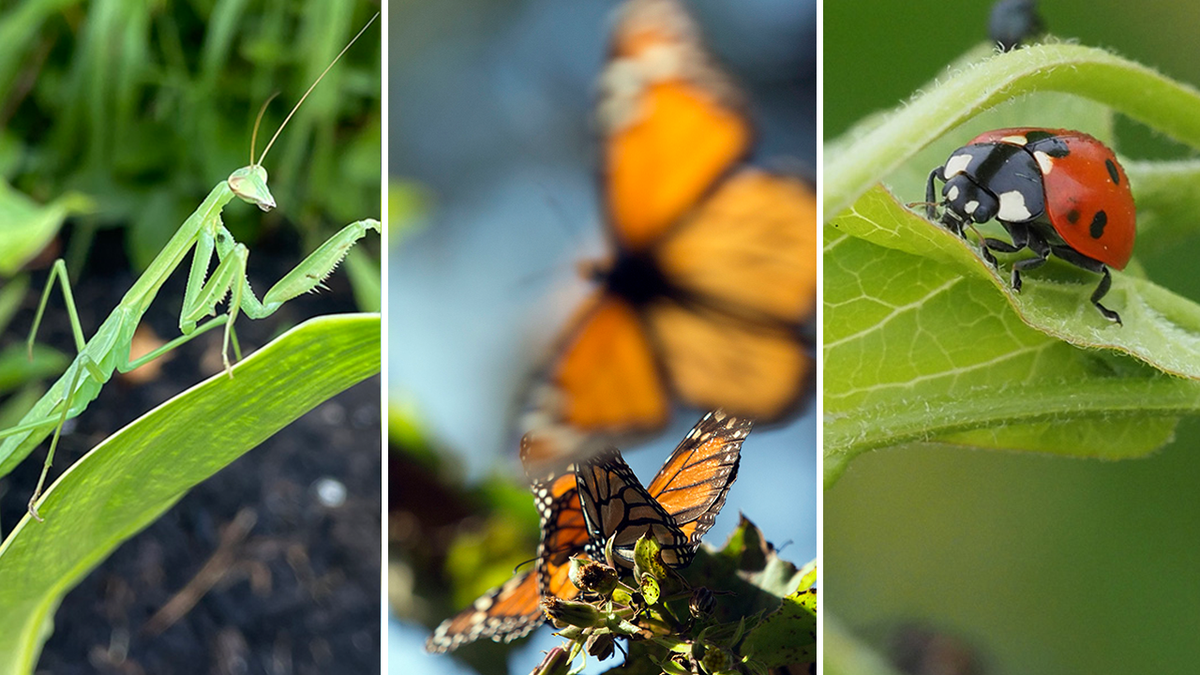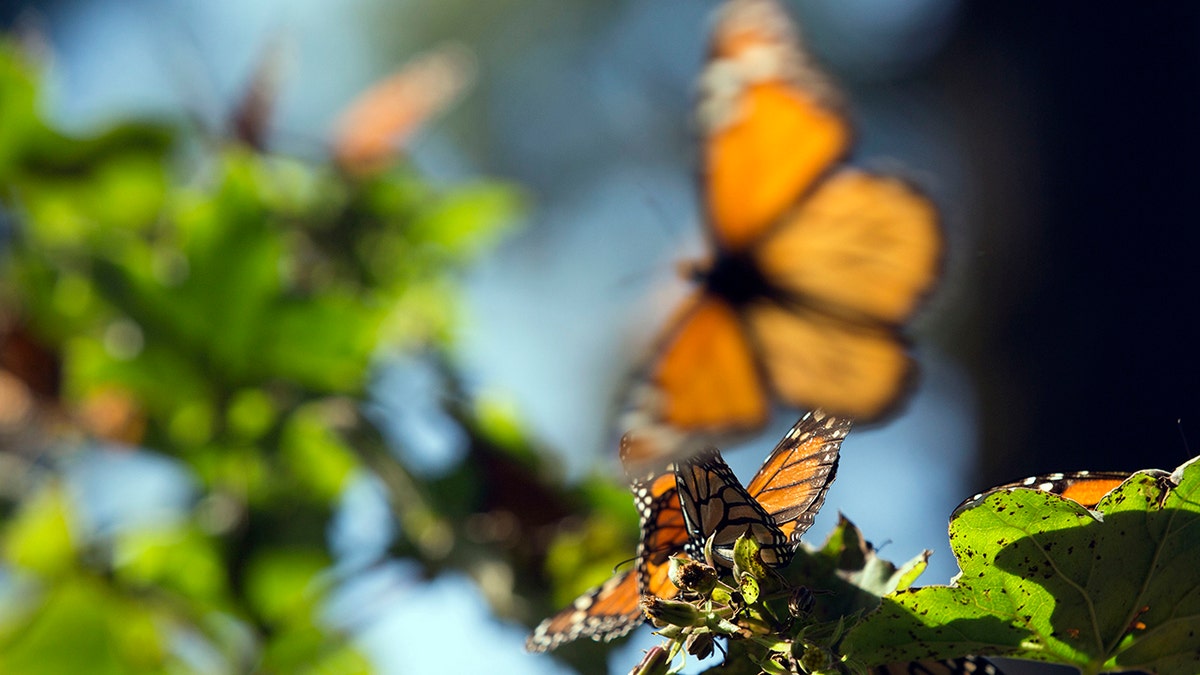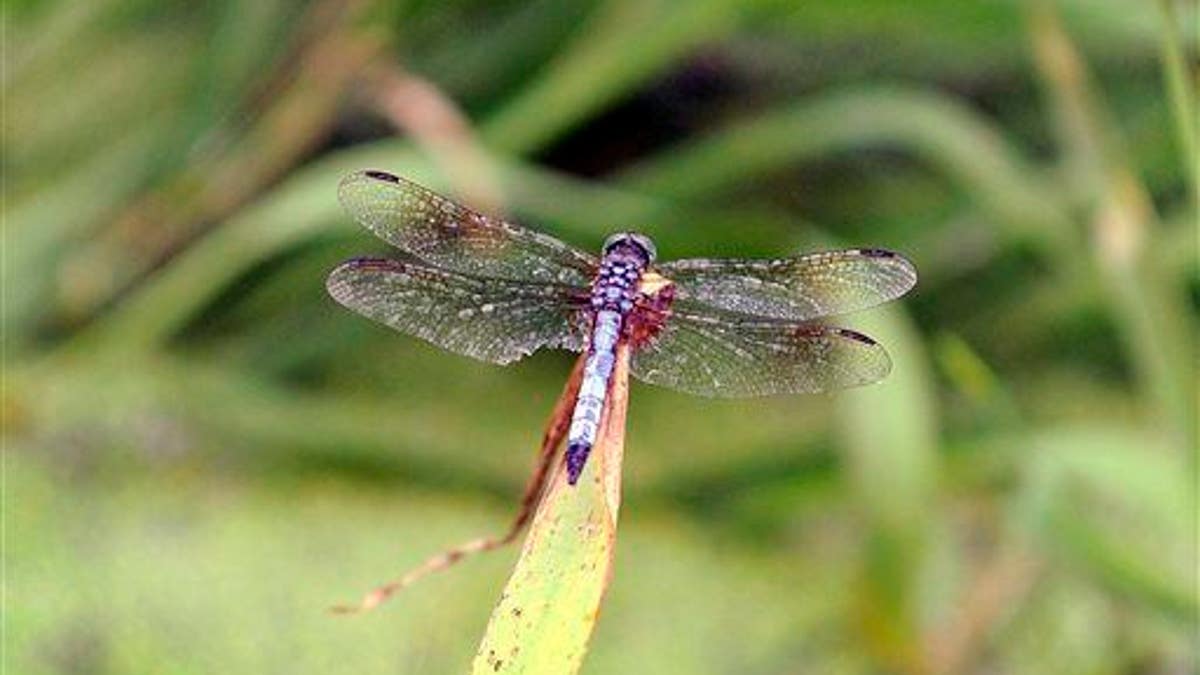Rapidly declining insect populations triggering end of mankind?
Researchers are saying that insect populations are declining at a rapid rate, and with the loss of those populations, mankind could face extinction.
When you’re in the presence of certain insects — you might be in luck.
Many bug species have been interpreted to bring good luck through different cultures, often based on historic events.
And while it's common knowledge that insects such as butterflies and ladybugs bring good fortune, how did these small species get their lucky bug label, anyway?
ENDANGERED MIGRATORY MONARCH BUTTERFLIES ARE FLUTTERING NEAR EXTINCTION – HERE'S WHY
Dr. Gene Kritsky, dean of behavioral and natural sciences at Mount St. Joseph University in Cinncinati, Ohio, is an expert on the cultural perception of insects.
He explained in an interview with Fox News Digital how these interpretations have been translated through history.

A praying mantis at left in New York's Lower Hudson Valley, July 2022; monarch butterflies fly near Oyamel trees at the Sierra Chincua Butterfly Sanctuary near Angangueo in Michoacan, Mexico, Jan. 2015; and a ladybug crawls on a plant in Brandenburg, Germany, June 2021. (Fox News Digital (left)/Susana Gonzalez/Bloomberg via Getty Images (center); Soeren Stache/picture alliance via Getty Images (right))
"A lot of it is tied to the culture that believes they are lucky," he said.
"And in many cases, these things are based on real events that may have happened in the past," he also said.

Dr. Gene Kritsky, dean of behavioral and natural sciences at Mount St. Joseph University in Ohio, is an expert on the cultural perception of insects. (Gene Kritsky)
Kritsky, a member of the Entomological Society of America, listed a few of the most famously fortunate bugs — starting with the lucky ladybug.
The ladybug
Ladybugs are arguably the most widely renowned bug when it comes to bringing good luck.
The ladybug, also known as the ladybird beetle, was first deemed lucky during the Middle Ages when a large aphid outbreak occurred in Europe, said Kritsky.
People living in Catholic areas prayed to Mother Mary to save them from the aphids that were running rampant.

A ladybug crawls on a green plant in Brandenburg, Germany, June 2021. (Soeren Stache/picture alliance via Getty Images)
Then along came the ladybug, which is a "voracious predator" to the aphid and feasted on the large food base. Eventually, it cut down on the infestation.
"They ate the aphids and saved the day," the expert said.
MURDER HORNETS GET NEW NAME IN WASHINGTON STATE AFTER INSECT GROUP CREATES ‘COMMON NAME’
The local populations began to call them "our lady’s bugs" or "our lady’s beetles" — hence the name ladybug.
"For that reason, they’ve always been associated with Mother Mary," he said.

A boy poses with a ladybug on his arm at Doral Glades Park in Doral, Florida, on Earth Day, April 22, 2022. (CHANDAN KHANNA/AFP via Getty Images)
Having a ladybug land on you is considered "very good luck," Kritsky explained — but killing a ladybug is bad luck.
"So that should be avoided at all costs," he said.
Ladybug mythologies even stretch to counting the number of spots on a ladybug’s back, which is thought to be an indicator of how many happy months you’ll be expected to have if one does land on you.
The praying mantis
The majestic praying mantis naturally gives off ethereal and spiritual vibes.
Kritsky considered these insects to represent "incredible prayers," based on their stature and their appearance of praying.

An up-close image of a praying mantis perched on a canna lilly's leaf in New York's Lower Hudson Valley, N.Y., July 2022. (Fox News Digital)
This made the species a symbol of good luck for the Catholic denomination dating back to the Middle Ages.
"They’re thought to be a symbol of piety and spiritualism," he said.
CATS CLASSIFIED AS ‘INVASIVE ALIEN SPECIES’ BY POLISH SCIENTIFIC INSTITUTE
These insects have also been called "praying nuns" in history, according to Kritsky, due to the flaring pronotum, located below the head on some mantids, that resembles habits worn by Catholic orders.
If found in or around your home, a praying mantis is thought to represent an angel that is watching over you.

A praying mantis spotted in New York's Lower Hudson Valley in July 2022. (Fox News Digital)
Kristky added that a praying mantis is also "very personable" and will follow the human gaze upon encounter.
Praying mantis populations have been on a noticeable decline, according to the expert, due to factors such as climate change and the use of general insecticides and herbicides.
Other insect populations are also dwindling, too — including fellow lucky bug the butterfly.
The butterfly
Even though species such as the migratory monarch butterfly have been recently classified as endangered, the beautiful butterfly is still an icon of good fortune.
Butterflies have been connected to folklore characters such as pixies — and have been associated with dreams and fairy tales.

Monarch butterflies fly near Oyamel trees at the Sierra Chincua Butterfly Sanctuary near Angangueo in Michoacan, Mexico, on Jan. 16, 2015. (Susana Gonzalez/Bloomberg via Getty Images)
Based on the metamorphosis of a butterfly — starting out as a caterpillar at the beginning of its life cycle — the insect is a consistent symbol of rebirth and regeneration, Kritsky pointed out.
"The idea that these things are lucky, in part, is because many people find inspiration," he said.
"They are symbols of beauty."
CALIFORNIA COURT RULES A BUMBLEBEE IS A FISH UNDER ENVIRONMENTAL LAW
In ancient Greek, the word for butterfly is "psyche," which is translated to "soul."
In Ancient Egypt, butterflies were a major symbol of death and the afterlife — and were often found as inscriptions in tombs.

Butterflies depicted in an illustration of the Ancient Egyptian afterlife. (Dr. Gene Kritsky)
Even though the ancient Egyptians did not have the same concept of heaven as western religions, their vision of the afterlife was filled with beauty and butterflies, Kritsky explained.
"The whole process of the tomb is the journey to the afterlife," he said.
"And the afterlife is known as this scene with plenty of fish and birds and butterflies … It's quite an inspirational symbol."
The cricket
In some cases, crickets may be considered noisy pests — but the chirping insect has been known for bringing good fortune for millennia.
The cricket has been determined to be a good luck charm in Asian culture; often, these were kept in cages and placed around residences.

Field cricket (Gryllus spp.) in Toronto, Ontario, Canada, August 2021. (Creative Touch Imaging Ltd./NurPhoto via Getty Images)
In many instances, crickets were used to guard houses, since their chirping would subside as intruders approached, said Kritsky.
"It was felt to be good luck if they were in the house," he said. "They helped protect the house, which is beneficial."
Crickets have been included in many Asian scroll paintings, especially those in Japan.

Evening Amusements at Ryogoku in the Eastern Capital (Toto Ryogoku yoasobi no zu), 1859; artist, Toyohara Kunichika. (Heritage Art/Heritage Images via Getty Images)
The insect was also considered good luck in Native American culture, while killing a cricket was thought to be bad luck.
The dragonfly
The regeneration of dragonflies has been viewed as a symbol of fortune throughout history, similar to the story of the butterfly.
The metamorphosis of a dragonfly requires the young nymph to leave the water source where it was hatched — and emerge as an adult dragonfly.

A dragonfly sits on pond grass while at Glenmere Park in Greeley, Colo., in July 2014. (AP Photo/The Greeley Tribune, Jim Rydbom)
In many cultures, dragonflies have been thought to be the boundary between "the change of subconscious dreams" to consciousness, Kritsky added.
"They’re often thought to symbolize prosperity, peace, strength, courage and harmony," he said. "And so, for that reason, that's considered a good luck insect."
The scarab beetle
Cousin of the dung beetle, the scarab beetle is a lesser-known lucky bug. Dating back to Ancient Egypt, the scarab beetle served as the iconographic image for the God Khepri.

Dung beetles (Scarabaeidae) rolling dung ball, Ndutu, Ngorongoro Conservation Area, Serengeti, Tanzania. (Sergio Pitamitz/VWPics/Universal Images Group via Getty Images)
The belief was that the sun would move across the morning sky by means of scarab beetle, just as the beetle rolls dung across the sands, according to Egyptian mythology, said Kritsky.
"In Ancient Egypt, they felt that the action of the insect in real life symbolized what their theological meaning was," he said.
Clay-carved amulets shaped like scarab beetles were often stitched into the linen of mummies, many cases at the upper left shoulder and in the chest pocket, to "help ensure rebirth," Kritsky detailed.
"The scarab is a symbol of regeneration and the continued rebirth every day," he said.
CLICK HERE TO GET THE FOX NEWS APP
"That's why they were considered to be a beneficial force in Egyptian mythology."



